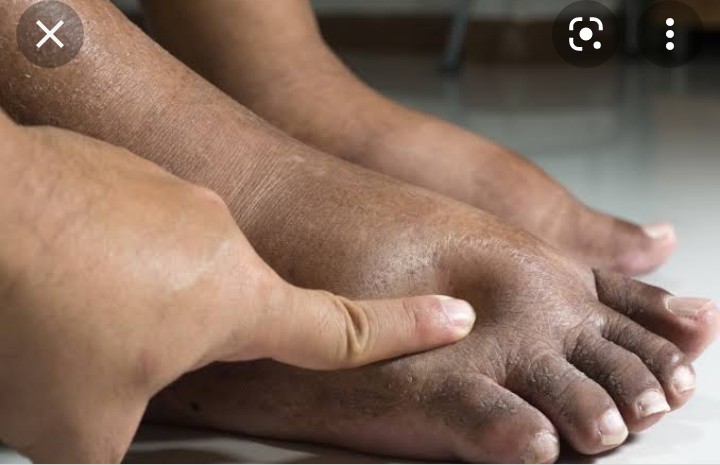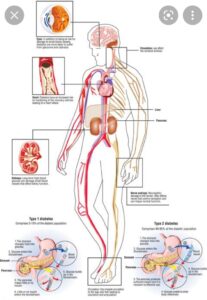
Sign of diabetes, swollen feet
by Aaron Kandola (MNT)
Definition
Types and causes
Risk factors
Symptoms
Treatments
Is it reversible?
Visiting a doctor
Summary
Diabetes develops when the body cannot make enough insulin or use it properly.
Insulin is a hormone that helps regulate blood glucose levels, and without a sufficient amount working correctly, health complications can occur.
There are many types of diabetes that can result from different factors, such as genetics or lifestyle choices.
Definition
Diabetes is a condition that occurs when a person is unable to regulate their blood glucose, or blood sugar, levels. Typically, the pancreas produces a hormone called insulin that allows cells to absorb glucose from the blood. This allows the body to use the glucose for energy and keep the blood sugar levels within a healthy range.
However, many factors can result in either the pancreas not producing enough insulin or cells being unable to use insulin effectively. This can cause too much glucose to accumulate in the blood and lead to the development of diabetes.
The American Diabetes Association (ADA) estimates that more than 34 million Americans had diabetes in 2018, and around 7 million of those cases were undiagnosed.
Evidence suggests that diabetes is the seventh leading cause of death in the United States. However, the true number of deaths is likely higher as death certificates do not consistently report diabetes as a cause. In addition to various symptoms, such as tiredness, vision problems, and increased thirst and urination, diabetes also increases the risk of many serious complications, such as heart disease, stroke, and kidney disease.
Types and causes of diabetes
Diabetes causes problems with how the body uses or produces insulin. The body breaks food down into glucose, which it releases into the bloodstream. Glucose is a source of energy that the body either takes into cells or stores for later use. Insulin is a hormone that guides glucose for use in cells or storage in the muscle or liver tissues.
The pancreas normally releases enough insulin depending on how much glucose is in the bloodstream. However, insulin is unable to properly regulate glucose in people with diabetes. This causes glucose to stay in the bloodstream so long that it becomes harmful to the body.
The reason insulin is unable to regulate glucose properly depends on the type of diabetes. The most common types are:
Prediabetes: Prediabetes, or borderline diabetes, occurs before type 2 diabetes develops. By this stage, blood sugar, blood pressure, and insulin resistance may start reaching harmful levels.
Type 1 diabetes: The body cannot produce enough insulin because the immune system mistakenly attacks insulin-producing cells in the pancreas. It is unclear what causes type 1 diabetes to develop, and it may be due to genetic and environmental factors.
Type 2 diabetes: The body fails to use insulin effectively enough to regulate blood sugar levels. For example, some tissues become insulin resistant and require more insulin. Type 2 diabetes can occur due to several factors, including genetics, unhealthy weight, and physical inactivity.
Gestational diabetes: Pregnancy can cause hormonal changes that lead to insulin resistance. Genetics and lifestyle factors may also contribute to gestational diabetes.
There are also several less common types of diabetes with different causes, such as:
Maturity-onset diabetes of the young (MODY): A collection of conditions where inherited genetic mutations limit a person’s ability to produce insulin. They typically develop in adolescence and young adulthood.
Latent autoimmune diabetes of adults (LADA): A form of diabetes where the immune system interferes with how insulin regulates blood sugar levels. The disease progresses more slowly than type 1 diabetes, but most people will move from oral medication to insulin treatment 6 months after diagnosis.
Neonatal diabetes: A rare form of diabetes that occurs in babies under 6 months old and prevents the pancreas from producing enough insulin.
Wolfram syndrome: A genetic disease that can cause diabetes with vision and hearing problems.
Alström syndrome: Another rare genetic disorder that can lead to type 2 diabetes with several other problems, including obesity, vision or hearing loss, and kidney failure.
Steroid-induced diabetes: Steroids are artificial versions of hormones that can increase blood sugar levels by causing the liver to release more glucose. This can result in insulin resistance.
Cystic fibrosis diabetes: A genetic condition that causes mucus to build up and damage the pancreas, leading to high blood sugar.
Type 3c diabetes: Also known as pancreatogenic diabetes, it occurs when illness, injury, or surgery of the pancreas causes it to stop producing insulin.
Risk factors
According to the Centers for Disease Control and Prevention (CDC), risk factors for diabetes can include:
genetics and family history
age, which includes younger ages for type 1 diabetes or older ages for type 2
overweight and obesity
physical inactivity
an unhealthy diet
hormone disorders, such as polycystic ovary syndrome
certain ethnic backgrounds, such as African American or Hispanic American
having certain diseases, such as non-alcoholic fatty liver disease
previously having gestational diabetes
giving birth to a baby over 9 pounds
Symptoms
Diabetes symptoms will vary depending on the type and cause but may include:
*fatigue
*blurred vision
*increased thirst and *urination
*hunger
*numbness in the hands and *feet
*persistent sores
*unexpected weight loss

Diabetes can also lead to serious health complications without treatment, such as heart disease or stroke.
Treatments
There are currently no cures for diabetes. But there are many forms of treatment available, depending on its type. The goal of treatment is to keep blood glucose levels within a healthy range to manage symptoms and the risk of complications.
Treatment for common types of diabetes can include:
Prediabetes: Losing weight by eating a healthy diet and increasing physical activity can prevent prediabetes from developing into type 2 diabetes.
Type 1 diabetes: Daily insulin doses are necessary to regulate blood sugar. These could be through a syringe, insulin pen, or pump.
Type 2 diabetes: Lifestyle changes may be necessary, such as a healthier diet or increased physical activity. Many people will also require oral medications and later may need insulin. In some cases, weight loss surgery may be an option.
Gestational diabetes: Lifestyle changes can help to lower blood sugar, such as dietary changes. Doctors may also suggest diabetes medicines where lifestyle changes are not working.
Is it reversible?
Some forms of diabetes could be reversible. For example, people with prediabetes can prevent type 2 diabetes and reduce their blood sugar levels by losing weight and regularly exercising.
People with type 2 diabetes can enter remission. This is where blood sugar levels stay within the normal range for at least 6 months without medications. It is achievable through healthy lifestyle changes.
However, other forms of diabetes are not reversible. For example, type 1 diabetes is an autoimmune disorder that requires daily insulin doses for life.
When to see a doctor
Diabetes is a serious condition that requires medical attention. Anyone experiencing signs or symptoms of diabetes should visit a doctor for advice and treatment. The CDC recommends seeing a doctor for a blood test for the following symptoms:
*urinating regularly, including at night
*frequent thirst and hunger
*unexpected weight loss
*blurry vision
*numbness or tingling in the hands or feet
*regular tiredness
*very dry skin
*frequent infections
Summary
Diabetes causes high blood sugar levels due to problems with insulin. The body either makes too little insulin or uses it poorly. There are many possible causes of insulin problems, which range from genetic to lifestyle factors.
Some forms of diabetes are reversible through lifestyle changes and treatments, such as prediabetes. Other types of diabetes, such as type 1 diabetes, are currently without a cure. However, regular insulin medication can help to manage symptoms and reduce the risk of complications.







